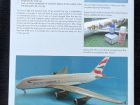

Author: Robert Jackson
Published: Pen & Sword
ISBN: 9781526774064
Bookshelf Browse with Geoff Coughlin (August 2021)
Get this book now at Pen & Sword
Take a browse inside now
Geoff Coughlin
Here’s some additional information from the publisher…
On 27 April 2005, an aircraft lifted away from the runway of Toulouse-Blagnac Airport under the power of six massive Rolls-Royce Trent 900 turbofan engines. It carried a six-man crew, it was making its first flight, and it was making history. For this was the Airbus A380, the largest passenger aircraft in the world.
Airbus Industries was a latecomer to the commercial airliner market, and initially struggled to win orders away from the well-established US giants, Boeing and McDonnell Douglas. Part of Airbus’s strategy for success was to offer customers distinct families of aircraft that could be tailored to meet a wide range of performance and capacity demands. Before 2005, the largest and arguably most important members of this family strategy were the Airbus A330 and 340 high-capacity airliners; then along came the A380.
With air traffic continuing to double every 15 years, the A380 was designed to meet the needs of the passengers and airports, while also delivering the level of efficiency necessary to protect the environment for future generations. The design incorporated two full-length decks with wide-body dimensions, meaning its two passenger levels offered an entire deck’s worth of additional space compared to the next largest twin-engine jetliner. With more seats than any other aircraft, the A380 offered solutions to overcrowding; needing fewer journeys to carry 60 percent more passengers, making it the perfect solution to airport congestion, fleet planning optimisation and traffic growth. Typical seating capacity was 525, although the aircraft was certified to carry up to 853 passengers.
By mid-2019, fifteen airlines were operating 238 aircraft throughout the world, the original customer being Singapore Airlines, which launched its first A380 service in October 2007. Production of the A380 peaked at 30 aircraft per year in 2012 and 2014. Then, in February 2019, the biggest customer, Emirates, announced that it was to reduce its latest order by 39 aircraft in favour of two other Airbus Models, the A350 and A330neo, a version using the same engines as the Boeing 787 Dreamliner. For Airbus, it was the last act. The Company announced that production of the A380 would cease by 2021.




